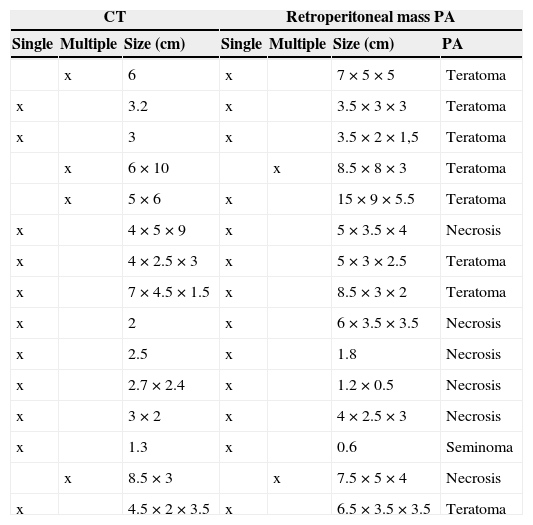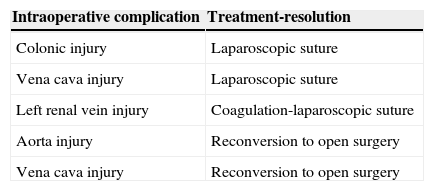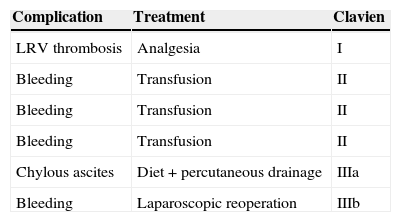Rescue lymphadenectomy for testicular cancer is a complex surgery, with a high number of complications. The laparoscopic approach appears to offer faster recovery and improved quality of life compared with open surgery. The aim of our study is to report on our experience and to define whether there is a limit (oncological, anatomical or technical) for laparoscopic management.
Materials and methodsA retrospective study was conducted that included 15 patients who underwent laparoscopic retroperitoneal lymphadenectomy after chemotherapy. In addition to epidemiological and oncologic variables, we analyzed the mean surgical time, intraoperative and postoperative complications, the mean hospital stay and the mean follow-up time.
ResultsThe mean surgical time was 294min (range, 180–240). There were 4 large-vessel vascular lesions, and all of which were large-volume retroperitoneal masses, with diameters >7cm. The rate of postoperative complications was 33%; there was only 1 case of Clavien >III. The mean hospital stay was 5.38 days (range, 2–9), and the mean patient follow-up was 28.9 months (range, 1–79). There was no recurrence in any of the cases.
ConclusionsThe laparoscopic approach is an oncologically safe option for the rescue treatment of testicular cancer. The complex location of these masses entails the onset of severe intraoperative complications. We have observed a clear relationship between vascular complications and large masses (>7cm). We therefore believe that it would be appropriate to establish a limit on the size for laparoscopic treatment.
La linfadenectomía de rescate en el cáncer de testículo es una cirugía compleja, con un elevado número de complicaciones. El abordaje laparoscópico parece ofrecer una recuperación más temprana y mejorar la calidad de vida respecto a la cirugía abierta. El objetivo de nuestro estudio es describir nuestra experiencia, y a partir de esta definir si existe algún límite (oncológico, anatómico o técnico) para el manejo laparoscópico.
Material y métodosEstudio retrospectivo de 15 pacientes sometidos a linfadenectomía retroperitoneal laparoscópica tras quimioterapia. Analizamos además de variables epidemiológicas y oncológicas el tiempo quirúrgico medio, las complicaciones intra y postoperatorias, la mediana de días de ingreso y el tiempo medio de seguimiento.
ResultadosEl tiempo quirúrgico medio fue de 294min (180-240). Hubo 4 lesiones vasculares de grandes vasos, tratándose en todos los casos de masas retroperitoneales de gran volumen, diámetro>7cm. La tasa de complicaciones postoperatorias fue del 33%, solo un caso de Clavien>III. La estancia hospitalaria media fue de 5,38 días (2-9) y el seguimiento medio de los pacientes de 28,9 meses (1-79), no observándose recidiva en ningún caso.
ConclusionesEl abordaje laparoscópico es una opción oncológicamente segura para el tratamiento de rescate del cáncer de testículo. La localización compleja de estas masas conlleva a que aparezcan complicaciones intraoperatorias graves. Hemos observado una clara relación entre las complicaciones vasculares y las masas de gran tamaño >7cm, por lo que creemos que sería conveniente establecer un límite de tamaño para el tratamiento laparoscópico.









